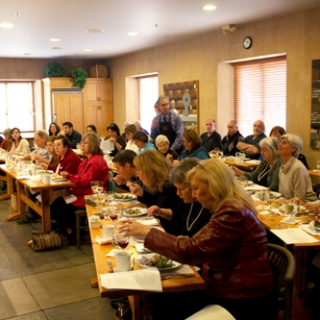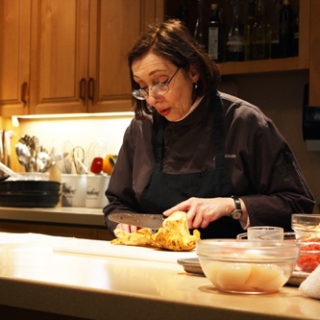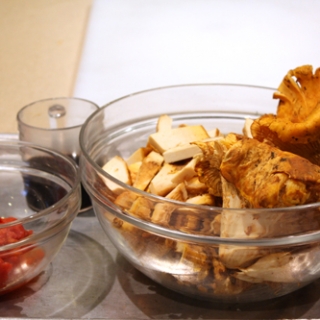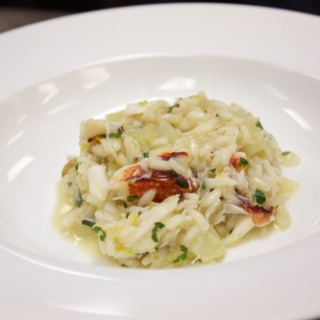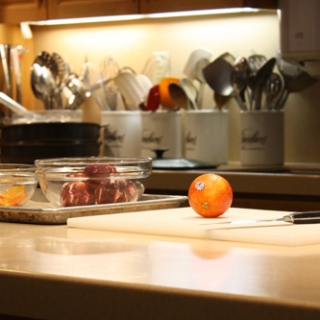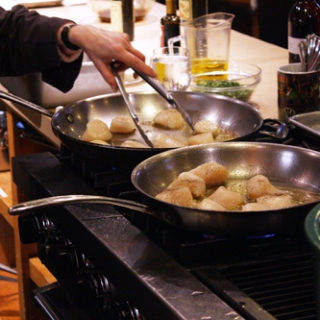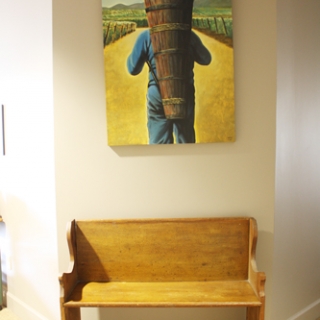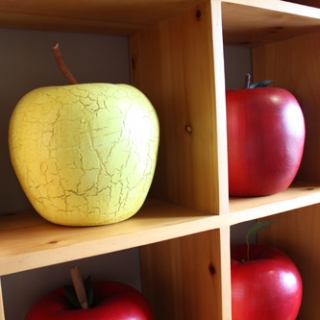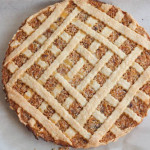We pulled up to the quaint Ramekins Cooking School and Inn in Sonoma, and knew I’d like this place as soon as I laid eyes on the spork and spoon handles on the front door.
I was invited by Ramekins to check out one of their many cooking classes and stay at their 6-room bed and breakfast. Cooking classes include both demonstration and hands-on classes, and are geared toward food enthusiasts and home cooks. Well, I’m always saying how I really need to make it up to wine country more often than I do, and this sounded like the perfect excuse!
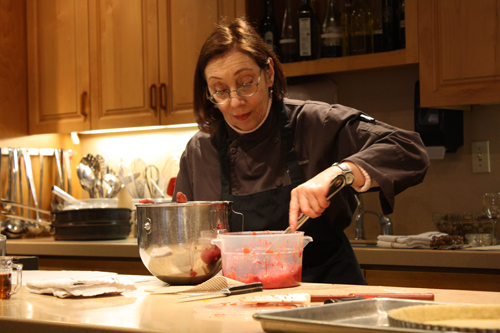
Joyce Goldstein
Plus, I saw that the esteemed Joyce Goldstein would be teaching a Regional Tour of Italy: The Veneto with this mouth-watering menu:
- Warm Scallop and Mushroom Salad
- Crab and Fennel Risotto with Meyer Lemon Gremolata
- Pork with Chestnuts served with Pumpkin Polenta
- Blood Orange Marmalade Tart
Yeah, let’s recap.
1) Weekend getaway in Sonoma. (Check)
2) Adorable B&B. (Check)
3) Cooking class with a culinary legend. (Check)
Right. Sign me up.

Cooking Class at Ramekins with Joyce Goldstein
Since this was a demonstration class, there was no actual hands-on cooking by us students, however, there was plenty of Q&A, discussion, and of course, tasting.
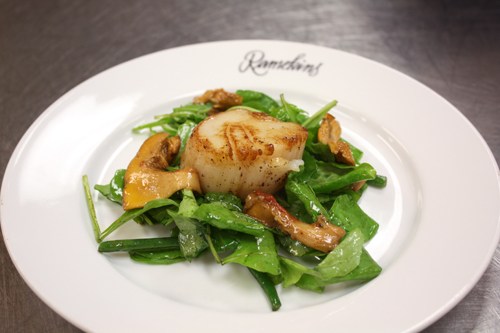
Warm Scallop and Mushroom Salad
Joyce was full of knowledge about Italian cuisine, tips and tricks when preparing the dishes on our own, and stories. As we nibbled on succulent seared scallops and gorgeous chanterelle mushrooms, she lectured us on proper and humane tomato care (“once you refrigerate a tomato, you commit murder”), gave us tips on how to select a good salad dressing-quality balsamic vinegar (“if the first ingredient is ‘caramel’ or ‘vinegar’, put it down; look for ‘grape must’ as a primary ingredient”), and warned us against overcooking the scallops (“they should be quivering in the middle”).
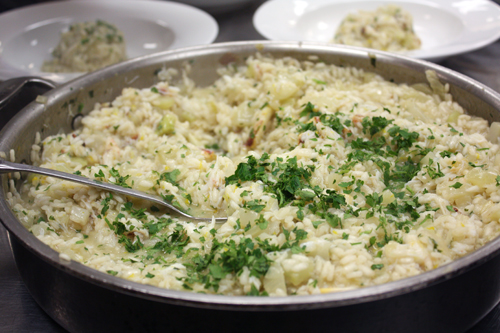
Crab and Fennel Risotto with Meyer Lemon Gremolata
As we tucked into the brightly flavored risotto made with sweet crab meat, fennel, and a gremolata of meyer lemon zest, parsley and garlic, we learned that the Venetians actually prefer their risotto on the soupy side.
Speaking of Venetians, I asked Joyce, why the Veneto? She replied that while this meal actually borrows from various regions of Italy, she originally wanted to highlight Venice because of its interesting culinary history born from its unique location. One of the first cities in the spice trade, the food of the Veneto was influenced by goods traded by merchants traveling in and out of the port (like Marco Polo, Venice’s most famous traveler). The food and drink of the Veneto includes an abundance of seafood, game meat (an influence of Yugoslavia), artichokes, radicchio, rice (rather than pasta), lighter wines, and grappa.
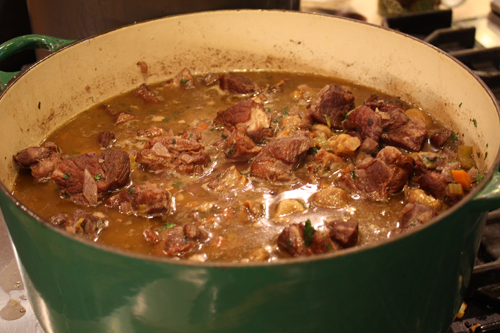
Pork Stew with Chestnuts
All this edification got me hungry. Good thing the pork stew was ready.
Originally prepared with wild boar, Joyce first had this dish at a farro farm in Abruzzo. Farro was the earliest wheat that was cultivated in Europe. It tastes like barley, is sweet and hazelnutty, and puffs up when it is cooked.
With a few adaptations made, our stew featured pork shoulder rather than boar, and a delicious pumpkin polenta rather than farro. The pork stew was rich and hearty, slow simmered with red wine (Pinot Noir and Valpolicella), aromatics, sage, and warm spices (juniper berries, cloves, and cinnamon). It also contained chestnuts, which added a superb sweetness and richness to the stew. They were delicious, and I don’t usually even like chestnuts!
We used vacuum-packed cooked chestnuts, but if you’re shelling fresh ones, Joyce let us in on a little secret she discovered to save your hands, and time. Cut an “X” on the flat side of the chestnuts, cutting through to the brown skin, then microwave them for a bit. The hard outer shell and bitter inner skin should easily come off afterward.
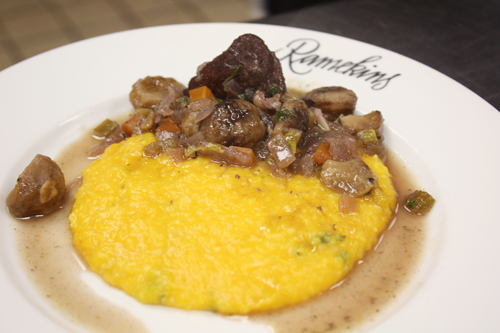
Pork with Chestnuts served with Pumpkin Polenta
Oh, and let’s not forget the polenta. The pumpkin polenta was heavenly. Granted, I may be biased, since as you may already know, I am a pumpkin/butternut squash/sweet potato freak.
But really, what is there not to love about this savory-sweet, rich combination of pumpkin, cornmeal, and parmesan cheese? Other than being utterly delicious, polenta is also pretty forgiving. Unlike risotto, which needs to hit the table as soon as it’s ready, “Polenta, you can baby,” as Joyce puts it. (Brands recommended for polenta: Giusto’s and Gold Pheasant.)
Also, a great trick we learned to avoid lumps in it was to start with the polenta in cold water rather than streaming it into boiling water like most recipes call for. Brilliant. Why didn’t I think of that before?
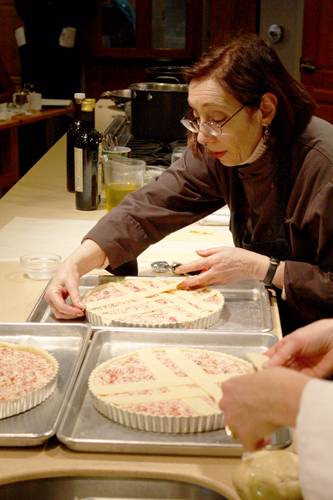
Joyce Goldstein, laying lattice
Now for my favorite part…the course that clinched it when I signed up for this class – the Blood Orange Marmalade Tart, which needless to say, did not disappoint. It was fragrant, perfumed by the gorgeous blood oranges and Grand Marnier (two of my favorite ingredients of all time), and had a perfectly buttery, flaky crust.
As Joyce so aptly describes, a blood orange tastes different from other oranges, it is really floral, “like an orange mixed with a rose.”
This tart is adapted from a recipe served at the Vineria Cozzi in Bergamo Alta. It is called Crostata di Marmellata delle Suore Trappiste, a tart filled with jam made by the Trappist nuns. The recipe takes a homemade orange marmalade and binds it with eggs and cornstarch. Fitting. It tastes divine.
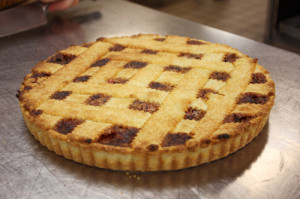
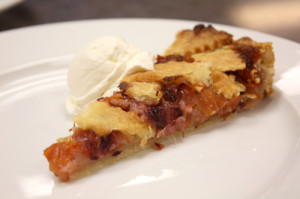
A few tricks of the trade when making this:
- Use a sharp vegetable peeler to remove all the zest from the oranges. It is the quickest way I’ve ever seen zest removed. After you have all the peel, chop it finely.
- Remember to discard the bitter pith.
- Blood oranges are small so you don’t need to really segment them, especially since it is all being cooked down anyway for the marmalade. Just chop them up into 1 inch pieces.
Other than this tart – which I’ve been thinking about ever since – what struck me was a comment that someone made towards the end of the class. She was a woman who was an old fan of Joyce’s restaurant, Square One, before it closed in 1996. She was not alone, as it seemed that the class was filled with devout fans. The woman used to come in from Central Valley for a night out at Square One, and wrote in once after being particularly taken by a certain apple tart. Joyce wrote her back (she answered every letter that came in), and said they make it en masse, so the translation may not be perfect, but nonetheless, here was the recipe. It worked beautifully, and this was the first chance the woman had to thank Joyce personally. The room burst into applause.
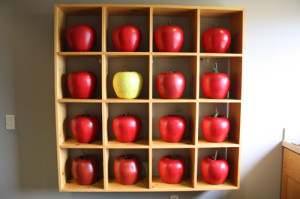
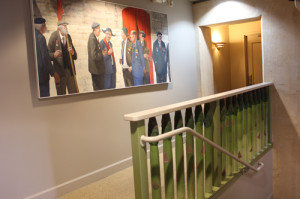
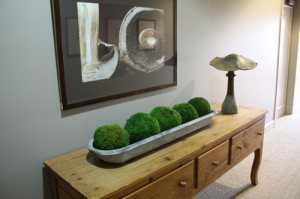
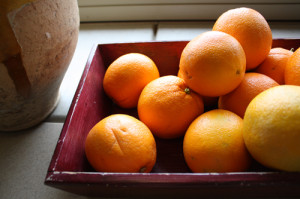
This story got me thinking about food and how our best memories of particular dishes or meals are inextricably tied to the people who made them special. It is not only about the food, but about the stories and the shared experience. Maybe that is why places like Ramekins make me so happy. Places that get it. They get the love of food (it’s written on the apple-adorned walls and asparagus-lined railing), and they get that people are looking to share that experience.
Jam filled lattice-topped tarts are popular all over Italy. In Rome they prefer cherry jam. Some tarts are prepared with apricot or berry preserves. At the Vineria Cozzi in Bergamo Alta they serve a Crostata di Marmellata delle Suore Trappiste, filled with jam made by the Trappist nuns. This recipe takes a home made orange marmalade and binds it with eggs and cornstarch. Blood oranges, now available at our markets, would add their special perfume and color, to the tart.
Ingredients
- 2 1/2 cups all purpose flour
- pinch salt
- 4 to 6 tablespoons sugar
- 12 tablespoons chilled unsalted butter
- 3 to 5 tablespoons ice water, as needed
- 3 large navel oranges or 5 to 6 blood oranges
- 1 1/3 cups sugar
- juice of 1 lemon
- 1/2 cup water
- 3 tablespoons cornstarch
- 4 tablespoons unsalted butter, softened
- 3 eggs
- 3 tablespoons Grand Marnier or other orange liqueur
Instructions
- Put the flour and salt and sugar in the container of a food processor or mixing bowl. Cut in the butter and pulse until the mixture resembles cornmeal. Gradually beat in the ice water. Turn dough out onto work surface and form into 2 flattened discs, one slightly larger than the other. Wrap in plastic and chill for at least an hour.
- Roll out the large disc between very lightly floured sheets of baker’s parchment until you have a circle that is 13 inches in diameter. Carefully ease it into a 9 inch pie plate or 10 inch tart tin with a removable bottom. Chill the crust.
- Wash and dry the oranges. With a sharp peeler carefully remove all of the zest from all 3 oranges and chop finely. Separate the oranges into segments and put them in a medium saucepan along with the chopped zest, 1/3 cup sugar, the lemon juice and the water. Bring to a boil and simmer for about 20 minutes, stirring form time to time. Let the mixture cool to room temperature. The filling can be made a day ahead of time and left at room temperature.
- Preheat oven to 450 degrees F.
- Place remaining sugar in a mixing bowl with the cornstarch and mix with a fork. Add the butter and beat until smooth and fluffy. Beat in the eggs, one at a time. Fold in the cooled marmalade and the Grand Marnier.
- Pour the filling into the pie crust. Roll out the remaining pastry between lightly floured sheets of baker’s parchment into a rectangle about 9 by 12 inches. Remove the top piece of parchment and cut into strips with a pastry wheel. Moisten the edge of the crust with a bit of water and then arrange the strips like a lattice on top of the filling.
- Bake 10 minutes then reduce the oven temperature to 350 degrees F and continue to bake the tart for 30 to 40 minutes or until filling is set and crust is slightly colored.
- Cool and serve with whipped cream.
Notes
Recipe and notes courtesy of Joyce Goldstein, from Perfect Pairings.
Recipe Source: LickMySpoon.com.
Hello! All images and content are copyright protected. Please do not use our images without prior permission. If you want to republish this recipe, please re-write the recipe in your own words, or simply link back to this post for the recipe. Thank you!
More Recipes Courtesy of Joyce Goldstein:
Warm Scallop and Mushroom Salad from Antipasti: Fabulous Appetizers and Small Plates
Crab and Fennel Risotto with Meyer Lemon Gremolata adapted from Back to Square One
Pork with Chestnuts served with Pumpkin Polenta from Italian Slow and Savory
Upcoming classes at Ramekins that caught my eye:
03/25/10, An Evening of Food and Wine Pairing (Demo, $85) with Joyce and her son, Evan Goldstein, a James Beard Award-winning master sommelier and career wine educator. Way to keep it in the family.
04/03/10, Top Five Desserts (Hands-on, $85) with Joy Wilson, author of Joy the Baker. Small world, I ran into Joy as we were leaving Ramekins…thought I had smelled something good baking downstairs! She’s returning to teach another class in April.
04/29/10, Perbacco Restaurant (Demo, $75) with Staffan Terje, chef/owner of Perbacco. Chef Terje will be showcasing fresh seasonal ingredients and cooking techniques that are the basis of haute cuisine. Which means, you can expect a haute Italian dinner from one of SF’s finest.
450 West Spain Street
Sonoma, CA 95476
(707) 933-0452
Disclosure: Cooking class and accommodations provided by Ramekins.
This recipe is brought to you by LICK MY SPOON
http://lickmyspoon.com/travel/cooking-class-at-ramekins-with-joyce-goldstein/
